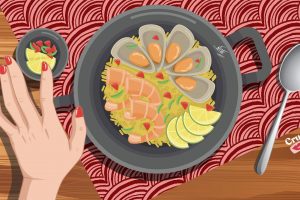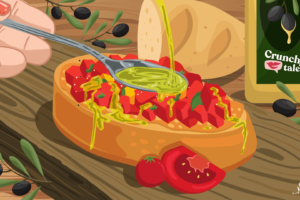A Pinch Of Salt: How To Choose The Right One
It’s a staple in every kitchen. It can easily improve the taste and texture of your dishes with just a pinch. And even though experts have demonstrated that salt is salt and usually contains the same amount of sodium (no matter the colour), gourmands know that different sizes, shapes and flavours of this precious mineral dictate the types of cooking they’re most suited for.
Salt’s relationship to flavour is multidimensional – Samin Nosrat chef and author of ‘Salt, Fat, Acid, Heat: Mastering the Elements of Good Cooking‘ says. – It has its own particular taste, and it both balances and enhances the flavour of other ingredients. Imagine taking a bite of a rich espresso brownie sprinkled with flaky sea salt. The salt minimizes the espresso’s bitterness, intensifies the flavour of the chocolate and offers a savoury contrast to the sugar’s sweetness. Does this mean you should simply use more salt? No. It means use salt better.
In the end, choosing the best one for your recipes really comes down to taste and preference but sometimes it could be quite challenging. Should we use crystalline or flaked? Kosher or Fleur De Sel? Red Hawaiian or black Hawaiian lava? According to Samin Nosrat, though all salt crystals are produced by evaporating water from saltwater brine, the pace of evaporation determines the shape those crystals take. These varying shapes and sizes can make a big difference in your cooking as “a tablespoon of fine salt will pack more tightly and can be two or three times ‘saltier’ than a tablespoon of coarser salt”.
Which salt to choose?
Here is the ultimate CrunchyTales guide to the most popular culinary salts that will help you decide what is best for your needs.
Sea Salt
It is typically much less refined than table salt and comes in both fine and coarse varieties. Highly mineral-enriched, it is produced by evaporation of seawater. It will vary in flavour and price, depending on where and how it’s made. For example, Fleur de sel, the ‘caviar of salts,’ is produced in small quantities and hand-harvested. Meant to be used as a finishing salt, it has a delicate flavour and texture. These crystals will complement anything from a fresh salad to a salmon fillet. Use it to add a pungent burst of flavour to just-cooked foods.
Grey salt is also universally praised for its high minerality, incredible moisture content and fine, irregular texture. Coloured by the clay from where it’s harvested, it is often called Celtic Sea Salt. It’s great on hearty foods, but can be used on everything; ideal for fatty meats and roasted root vegetables. Both are best used as finishing salt for fish, seafood, caramels, chocolate chip cookies, and other sweets.
Kosher Salt
A popular choice for everyday cooking as it contains fewer additives and has a cleaner taste compared to processed table salt. When used in cooking, it can add a crunchy texture to dishes and even drinks. Remarkably versatile, Kosher Salt is made by compacting granular salt collected from mines and deposits. It has irregularly shaped flakes that dissolve easily and relatively evenly. Sprinkle it in sauces, use it to cure a ham, fold it into soups.
Himalayan Pink Salt
Pink Himalayan salt is known as a finishing salt because it is generally used at the end of cooking to add flavour and a crunchy texture to the meal. It comes from ancient seabeds in the Himalayan mountains and its pink colour is due to its rich iron content. Himalayan salt can also be used as a cooking or finishing salt. You can also use it to rim the edge of a glass for a warm-weather cocktail.
When hand-cut into slabs, it could be used as a surface for serving food.
Hawaiian Salts
Originating from Hawaii, both Black and Red salts are unrefined and volcanic. The first owes its colour to its content of activated charcoal. This finishing salt is very coarse; great with meat, seafood and fruits. The Red one gets its colour from the iron oxide in volcanic clay. Full of trace minerals, it complements pork, seafood, ceviche and more. It’s not as coarse as black salt, but not as fine as table salt: what’s great about it is how amazing it looks as a garnish.
The Secret Art Of Layering Salt
Once you have chosen your favourite salt, start to play with it according to your recipe. Add crystals only after you’re satisfied with the balance of flavours: do it gradually, stop to taste and adjust as needed.
From capers and bacon to miso paste and cheese, there are many sources of salt beyond crystals – Samir Nosrat explains-. Working more than one form of salt into a dish is what I call layering salt, and it’s a terrific way to build flavour.
In general, use coarse, unrefined salt for fermenting vegetables (sea salts and Himalayan rock salt are the best) and do not use those ones that contain anti-caking agents or iodine because it can inhibit the beneficial bacteria in a fermented vegetable. If you want to elevate the taste of a dish, use finishing salts. Select pink, red, or black salt to add a burst of colour.
And unless you have been told by your doctor to limit salt consumption, you can relax about your sodium intake from home-cooked food. In almost every case, anything you cook for yourself is lower in sodium than restaurant food.
***
Quick Facts
- Salt is salt, used for flavour, and not to add nutritional value.
- One teaspoon of salt contains around 2400 mg of sodium.
- Fancier packaging and marketed health claims make salt more expensive, but not healthier. All salts, regardless of different textures or colour, remain comparable in sodium content.
- Consuming high levels of salt can cause increased blood pressure and water retention.
- Most people require less than 225 micrograms of iodine daily




